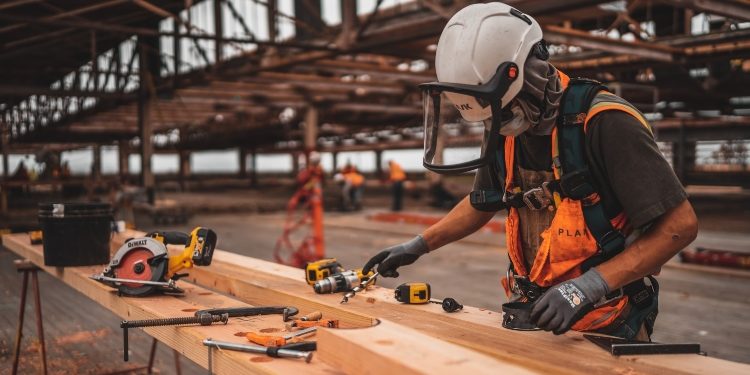Construction sites are known for having a variety of risks that might threaten workers’ health. These dangers might range from minimal to substantial in terms of the risk they represent to the workers on the building site. According to health and safety rules, employers are largely responsible for implementing workplace health and safety policies and ensuring their employees a healthy and secure environment. However, it is critical to implement effective control measures against these dangers in the workplace to protect the safety of employees and others. To take effective measures, it is important to understand what hazards are present at the construction site. This blog will describe the top five most prevalent and dangerous risks on construction sites.
Top five hazards
- Falls
Falls on a building site can occur for a variety of causes. Slips and falls from objects in the path may lead to it, as can operating at heights or in confined places. On the other hand, falls are one of the main causes of injury and death on construction sites. Falls are the biggest cause of mortality in the construction sector, accounting for around one-third of all deaths, according to the Occupational Safety and Health Administration (OSHA). As stated in this fact, falls on a construction site are lethal. Hence appropriate precautions must be put in place to limit the risk of falling on a construction site.
To avoid slips and falls, employees must keep their workplace clean and neat and proof of all objects that could cause slips and falls. Installing guardrails in sloped parts of a construction site can effectively reduce slips and falls.
Installation of fall arrest systems could be one handy tool to prevent falls from heights. Another pivotal solution to solve your falls from heights problem could be the provision of appropriate working at height training. Training is one of the most effective health and safety policies, and most laws require companies to give their staff sufficient training to protect their safety. Responsible supervisors or employers should provide working at height training to their employees to guarantee that they can do their tasks safely and effectively at height.
- Struck by incidents
With so many jobs being completed on a construction site, being struck by a moving object is a regular hazard in the workplace. This includes workers who are hit by moving vehicles, machines, or items. Strike-by occurrences are the second biggest cause of mortality in the construction sector, with an average of 80 fatalities and over 11,000 non-fatal injuries per year, according to OSHA. As a result, these occurrences might result in significant injuries or even death.
It is critical to use barriers, warning signs, and personal protective equipment to avoid injuries and accidents caused by moving objects. Barriers would allow workers to stay in their respective areas and not venture into other areas, reducing the likelihood of an incident. Signs would assist workers in remaining alert to moving objects and ensuring their safety.
- Asbestos and chemical hazards
Various hazardous chemicals and biological hazards, such as fumes and asbestos, can be found on many construction sites and can be harmful for the workers’ health. Asbestos, mold, and other substances can all cause serious health problems. Workers on construction sites, particularly those working on older sites, may be exposed to asbestos fibres, which can be harmful to their health. Asbestos inhalation can lead to asbestosis, which can be fatal. As a result, workers should be aware of the presence of asbestos-containing fibres on the construction site. One appropriate solution is asbestos awareness training, which educates employees on identifying asbestos-containing materials and ensuring their safety while exposed to it.
To ensure safety, employees should wear proper PPE when handling hazardous and chemical substances on a construction site. Employers should also install ventilation so that fumes and chemical gases are not trapped in one area for an extended period of time.
- Electrocution
Electrical hazards are a major concern on construction sites. The majority of the processes taking place on a construction site are mostly electrically powered. As a result, if proper safety precautions are not taken, this raises the likelihood of electrical hazards. Electrocution is the fourth leading cause of death in the construction industry, according to OSHA, with 71 fatalities and over 300 non-fatal injuries each year. It is critical to provide proper training on safe work practices and the use of insulated tools and equipment to prevent electrocution. Employers are also responsible for testing electrical appliances on the construction site to detect potential faults such as electric leaks and faults in those appliances. As the use of electrical appliances on a construction site is large, these appliances demand maintenance every once in a while. However, regular maintenance and repair of such electrical appliances is not a task for everyone. Therefore, it is recommended to try taking on a PAT testing course, which would train you and your employees on how they can identify the defects and faults in electrical appliances and repair them to ensure their well-being.
- Caught in between incidents
According to OSHA, caught-in or between incidents are the third leading cause of death in the construction industry, with 50 fatalities and over 2,000 non-fatal injuries occurring yearly. Excavators, backhoes, and bulldozers are frequently involved in these incidents. Workers are caught or crushed between heavy equipment or materials in caught-in or between incidents. These incidents can result in serious injuries or even death.
To avoid such incidents, workers should follow all safety procedures the employer implements. Regular maintenance and equipment inspections can aid in the identification of potential hazards and the prevention of accidents. Furthermore, training would enable workers to recognize potential hazards and take appropriate precautions.
Conclusion
To summarize, construction sites are naturally hazardous places to work. Workers can reduce the risk of accidents and injuries by taking appropriate precautions and adhering to established safety guidelines. Employers must provide adequate training, equipment, and safety protocols to protect their employees. Workers must also follow all safety guidelines and protocols to ensure their own safety and the safety of their coworkers. Working together, we can make construction sites safer and protect workers from harm.Meta Description: Discover the top five construction site hazards and how to avoid them. Learn how to keep yourself and your team safe from falls, electrocution, and other hazards.
David Prior
David Prior is the editor of Today News, responsible for the overall editorial strategy. He is an NCTJ-qualified journalist with over 20 years’ experience, and is also editor of the award-winning hyperlocal news title Altrincham Today. His LinkedIn profile is here.













































































